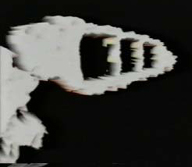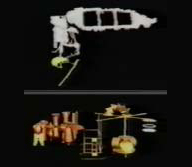Voyage through the Large Glass: With the Very First Computer Animation of the Large Glass
click to enlarge

Brochure for Jean Suquet,
Voyage through the Large
Glass,Centre Georges
Pompidou, 24 October,
1995-12 February, 1996
A note on the translation:
Some French words from the original have been included in this translation to show the wordplay that takes place in Jean Suquet’s text which cannot be translated exactly into English. Also, in the original, several words were italicized for emphasis. Those words have been underlined in the translation since the added French has been set off in italics, as is customary. These minor adjustments have been made in order for the reader to appreciate as much of the intentioned subtlety as possible.
Click images for Jean Suquet’s animation of the Large Glass
-
A slide of the Large Glass is projected onto the white wall of a room in a garret. On the right, a door, it’s obvious. Closed. The narrator enters into the projection cone and, having become prey to the cast shadows he transfuses his breath into them. Duchamp left three-fourths of the Large Glass transparent so that in the filigree of the extravagant machinery parading in the foreground we could read a poem. Without words [mots], with no motor [moteur].
The initial lighting crackles with the title: The Bride stripped bare by her bachelors, even. In the sky, the Bride. On the ground, the bachelors. Between them, the horizon line. This line, Duchamp says, is the Bride’s clothing. Poor bachelors dreaming of stripping her bare! They carry before them in their own gaze the veil they can’t wait to unfasten. The horizon line is an imaginary boundary that recedes as one moves towards it. An inevitable escape from which the bachelors will have to disenchant themselves. Let’s join the nine red fellows who look like our brothers. Dressed in tight uniforms, nailed to the ground by their lead soles, they’re nevertheless in a flutter by a leak of illuminating gas, which in 1912 was the blood of the city lights. This spirit rushes into a journey through which must pass all states of matter. Solidified and liquefied into a puddle, it wanders around until some weight, falling down from who knows where, makes it splash out. It explodes. It declares its flame. It is dazzled by its own light that is projected into the sky by a playful configuration of mirrors. In the sky, the Bride is nude in every sense of the word. She unfastens her clothing, which falls to her feet and covers the world around. She escapes all outline, denies all representation. On the Large Glass we can only make out a hieroglyph too difficult to decode until we recognize, within it, the jagged chrysalis of a queen bee that the nuptial flight has dissolved into the clouds.
-
This queen is alive. Her pulse beats. From fair weather to tempests, she blossoms into a milky way flesh color. And the flesh is made word. Some letters, carried by the wind, bring orders and authorizations to the bachelors. Oh yes! In the Large Glass, the woman dictates law. How does she have her will come down to the ground? Thanks to a deus ex machina which links the top and the bottom. Duchamp personified it with a pedestal table. The god knocks at the door dressed up like a vagabond. The goddess dresses up like a whore and cracks the vocabulary with her hot lips. This last guest to the wedding is announced: the Tender of Gravity. A doctor, undisciplined in the transparency, not only takes action so that the weighty time [le pesante heure] gets rid of gravity [la pesanteur], but he also gives his remedy to anyone who cares to hear it: so heal! [guéris donc!] And if you’re cheerful, then laugh! [Et si tu es gai, ris donc!] To heal gravity is to laugh. And so, resumed in long strides, is the fairy tale of modern times, which tells us how the journey of the illuminating gas ends in l’éblouissement [the dazzling]. How the flight of the Bride drives it towards l’épanouissement [the blossoming]. Powered by la jouissance [sensual pleasure].
At the heart of these three words, if one hasn’t lost the innocence of looking for “or” [gold] in “oreille” [ear], here is the word at the end: OUI [YES]. The narrator walks back through the cast shadows, pushes the door, leaves. In other words, he ENTERS the Large Glass. In the black rectangle where the Tender of Gravity DANCES, at the height of the horizon, a naked female arm brandishes a gaslamp. Lit up.


